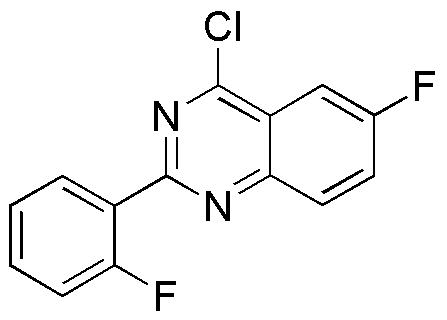4-Chloro-6-fluoro-2-(2-fluorophenyl)quinazoline is widely utilized in research focused on:
- Pharmaceutical Development: This compound serves as a key intermediate in the synthesis of various pharmaceuticals, particularly in developing targeted cancer therapies.
- Biological Research: It is used in studies investigating the inhibition of specific enzymes, helping researchers understand disease mechanisms and potential treatments.
- Material Science: The compound is explored for its properties in creating advanced materials, such as polymers with enhanced thermal stability and chemical resistance.
- Agricultural Chemistry: It has applications in developing agrochemicals, contributing to the formulation of effective pesticides that target specific pests while minimizing environmental impact.
- Diagnostic Tools: This chemical is being researched for its potential use in diagnostic imaging agents, aiding in the early detection of diseases through improved imaging techniques.
General Information
Properties
Safety and Regulations
Applications
4-Chloro-6-fluoro-2-(2-fluorophenyl)quinazoline is widely utilized in research focused on:
- Pharmaceutical Development: This compound serves as a key intermediate in the synthesis of various pharmaceuticals, particularly in developing targeted cancer therapies.
- Biological Research: It is used in studies investigating the inhibition of specific enzymes, helping researchers understand disease mechanisms and potential treatments.
- Material Science: The compound is explored for its properties in creating advanced materials, such as polymers with enhanced thermal stability and chemical resistance.
- Agricultural Chemistry: It has applications in developing agrochemicals, contributing to the formulation of effective pesticides that target specific pests while minimizing environmental impact.
- Diagnostic Tools: This chemical is being researched for its potential use in diagnostic imaging agents, aiding in the early detection of diseases through improved imaging techniques.
Documents
Safety Data Sheets (SDS)
The SDS provides comprehensive safety information on handling, storage, and disposal of the product.
Product Specification (PS)
The PS provides a comprehensive breakdown of the product’s properties, including chemical composition, physical state, purity, and storage requirements. It also details acceptable quality ranges and the product's intended applications.
Certificates of Analysis (COA)
Search for Certificates of Analysis (COA) by entering the products Lot Number. Lot and Batch Numbers can be found on a product’s label following the words ‘Lot’ or ‘Batch’.
*Catalog Number
*Lot Number
Certificates Of Origin (COO)
This COO confirms the country where the product was manufactured, and also details the materials and components used in it and whether it is derived from natural, synthetic, or other specific sources. This certificate may be required for customs, trade, and regulatory compliance.
*Catalog Number
*Lot Number
Safety Data Sheets (SDS)
The SDS provides comprehensive safety information on handling, storage, and disposal of the product.
DownloadProduct Specification (PS)
The PS provides a comprehensive breakdown of the product’s properties, including chemical composition, physical state, purity, and storage requirements. It also details acceptable quality ranges and the product's intended applications.
DownloadCertificates of Analysis (COA)
Search for Certificates of Analysis (COA) by entering the products Lot Number. Lot and Batch Numbers can be found on a product’s label following the words ‘Lot’ or ‘Batch’.
*Catalog Number
*Lot Number
Certificates Of Origin (COO)
This COO confirms the country where the product was manufactured, and also details the materials and components used in it and whether it is derived from natural, synthetic, or other specific sources. This certificate may be required for customs, trade, and regulatory compliance.


